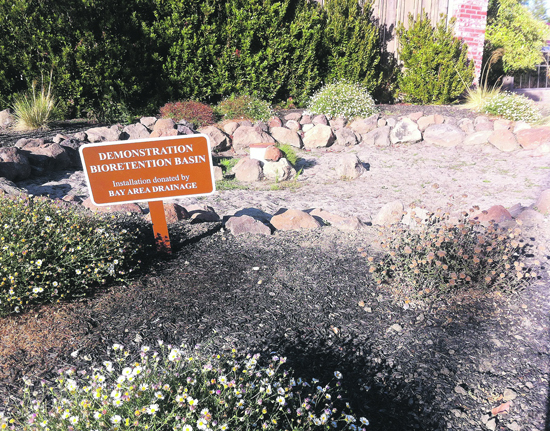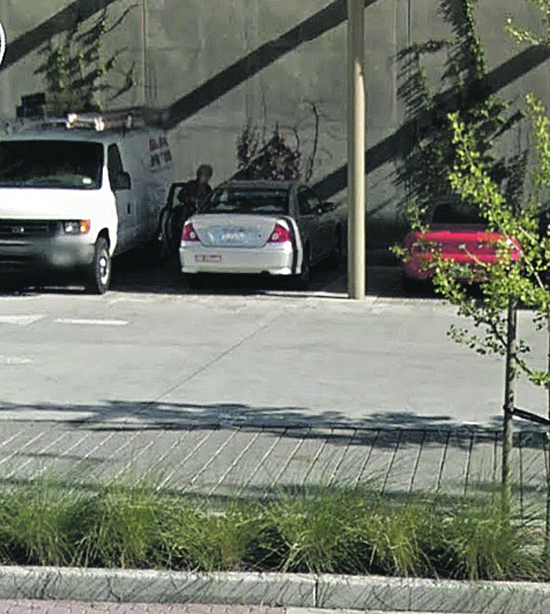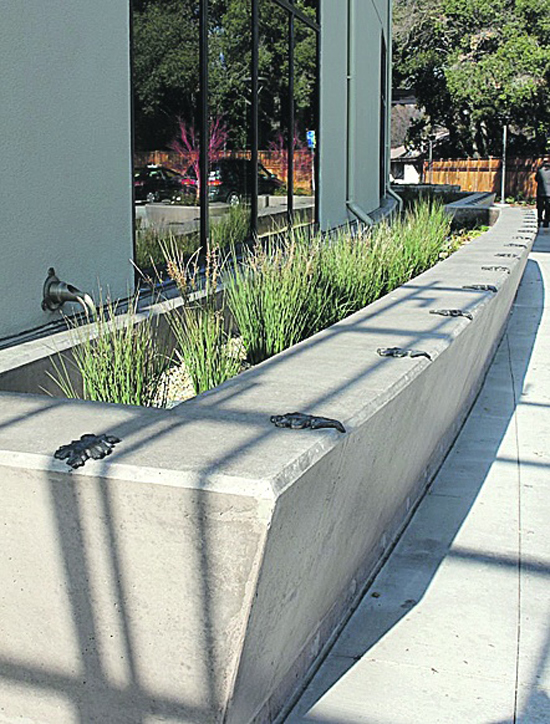 | | | The bio-retention basin in front of 331 Rheem Blvd in Moraga Photo Sophie Braccini
| | | | | | As of December 1 of this year, homeowners adding more than 2,500 square feet of impervious surface to their property will have to mitigate runoff. In plain English, if you add square feet to your existing home, redo your driveway, add an impervious deck and the total surface is more than 2,500 square feet, the California Regional Water Quality Control Board requires all water from your gutters and driveways to be somehow caught or redirected from common drains.
 According to the Contra Costa Clean Water Program the benefits of having water go in the ground rather than running directly into storm drains is two-fold: First it avoids dramatic swells of creeks in case of a storm; second, the earth filters some of the chemicals that can be contained in the runoff. Large developments have dealt with similar requirements for years and give examples of what can be done.
According to the Contra Costa Clean Water Program the benefits of having water go in the ground rather than running directly into storm drains is two-fold: First it avoids dramatic swells of creeks in case of a storm; second, the earth filters some of the chemicals that can be contained in the runoff. Large developments have dealt with similar requirements for years and give examples of what can be done.
 "Homeowners, according to the new State requirement, will have different options to divert the flows and we are working on the detailed specifications," says Cathleen Terentieff, Orinda Associate Engineer/Stormwater Program Manager. The different options are to direct roof runoff into cisterns or rain barrels for reuse and onto vegetated areas; to direct runoff from sidewalks, walkways, and/or patios onto vegetated areas; and to construct sidewalks, walkways, and/or patios with permeable surfaces. In short, homeowners can collect water, divert it to planters or gardens, and/or construct their driveways with permeable material.
"Homeowners, according to the new State requirement, will have different options to divert the flows and we are working on the detailed specifications," says Cathleen Terentieff, Orinda Associate Engineer/Stormwater Program Manager. The different options are to direct roof runoff into cisterns or rain barrels for reuse and onto vegetated areas; to direct runoff from sidewalks, walkways, and/or patios onto vegetated areas; and to construct sidewalks, walkways, and/or patios with permeable surfaces. In short, homeowners can collect water, divert it to planters or gardens, and/or construct their driveways with permeable material.
 The collection option is pretty straightforward. "Homeowners can collect the water in a barrel and use that water for their own garden later," says Terentieff.
The collection option is pretty straightforward. "Homeowners can collect the water in a barrel and use that water for their own garden later," says Terentieff.
 The more complex approach is diversion to a filtering, vegetated area. In Moraga, a bio-retention basin was donated and built by Bay Area Drainage in front of the Town's building at 331 Rheem Boulevard, as a demonstration site. Bioretention basins, also called bioswales or rain gardens, are commonly used to filtrate runoffs and not increase the peak flow from pre-development. The new development proposed in Moraga by SummerHill includes three bioswales.
The more complex approach is diversion to a filtering, vegetated area. In Moraga, a bio-retention basin was donated and built by Bay Area Drainage in front of the Town's building at 331 Rheem Boulevard, as a demonstration site. Bioretention basins, also called bioswales or rain gardens, are commonly used to filtrate runoffs and not increase the peak flow from pre-development. The new development proposed in Moraga by SummerHill includes three bioswales.
 "Bioretention basins are built with a mix of soil and planted with specific plants," says Civil Engineer Greg Miller who works with SummerHill. "The water percolates through the mixture, the soil and root systems cleanse the water, there is no stagnant water on the surface and it can be very attractive." In our area where the sub-terrain is not permeable, a sub-drain is installed that will divert the clean water to the conventional drainage system.
"Bioretention basins are built with a mix of soil and planted with specific plants," says Civil Engineer Greg Miller who works with SummerHill. "The water percolates through the mixture, the soil and root systems cleanse the water, there is no stagnant water on the surface and it can be very attractive." In our area where the sub-terrain is not permeable, a sub-drain is installed that will divert the clean water to the conventional drainage system.
 In Orinda, the Wilder neighborhood was also designed with runoff mitigation in mind. "All water runoff from the Wilder neighborhood, including from streets, homes and hillsides, flows through a carefully-designed combination of landscaped bioswales and a series of six water quality ponds," says Jason Keadjian for Wilder. "The bioswales and ponds naturally filtrate and treat runoff water before it leaves the site."
In Orinda, the Wilder neighborhood was also designed with runoff mitigation in mind. "All water runoff from the Wilder neighborhood, including from streets, homes and hillsides, flows through a carefully-designed combination of landscaped bioswales and a series of six water quality ponds," says Jason Keadjian for Wilder. "The bioswales and ponds naturally filtrate and treat runoff water before it leaves the site."
 The cost of a bioswale for homeowners varies, since they can build it themselves or ask a contractor/landscape architect to do it. A simpler version of a bioswale for a home can be a filtering planter.
The cost of a bioswale for homeowners varies, since they can build it themselves or ask a contractor/landscape architect to do it. A simpler version of a bioswale for a home can be a filtering planter.
 Permeable pavers for driveways, patios or parking areas are also an option to limit runoff, but it is not a method of treatment. "A good example of permeable pavers in a parking lot can be seen at the Lafayette Library," says Karen McCardle of the landscaping firm Hansen McCardle in Lafayette. "The pavers themselves are not necessarily porous, but there is space filled with gravel between them so the water goes into the ground rather than running off into the creeks."
Permeable pavers for driveways, patios or parking areas are also an option to limit runoff, but it is not a method of treatment. "A good example of permeable pavers in a parking lot can be seen at the Lafayette Library," says Karen McCardle of the landscaping firm Hansen McCardle in Lafayette. "The pavers themselves are not necessarily porous, but there is space filled with gravel between them so the water goes into the ground rather than running off into the creeks."
 There are other types of pervious treatment: pervious concrete or asphalt. "We considered pervious asphalt for the new parking lot the Town is building by the Skate Park along Moraga Road, but the cost was too high," explains Moraga Parks and Recreation Director Jay Ingram. "Instead we are building a bioretention basin that will be located between the road and the parking lot and fully landscaped." Other less expensive permeable treatments include granular material such as crushed shells, gravel, aggregate base, cobbles, or wood mulch.
There are other types of pervious treatment: pervious concrete or asphalt. "We considered pervious asphalt for the new parking lot the Town is building by the Skate Park along Moraga Road, but the cost was too high," explains Moraga Parks and Recreation Director Jay Ingram. "Instead we are building a bioretention basin that will be located between the road and the parking lot and fully landscaped." Other less expensive permeable treatments include granular material such as crushed shells, gravel, aggregate base, cobbles, or wood mulch.
 The ultimate step after collection and filtration is, of course, re-use. There is no current State mandate regarding that aspect.
The ultimate step after collection and filtration is, of course, re-use. There is no current State mandate regarding that aspect.
 For more information, visit
For more information, visit
 cccleanwater.org.
cccleanwater.org.

|


